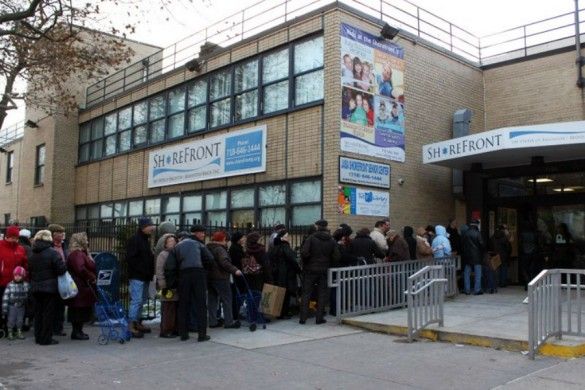Shorefront Y Seeks To Be Central Relief Hub For Future Disasters In Southern Brooklyn

The Shorefont YM-YWHA (3300 Coney Island Avenue) is a neighborhood organization that’s rising to the challenge of continuous local disaster recovery in the wake of Superstorm Sandy. Currently, they’re responsible for everything from assigning volunteer contractors, to repairing homes and giving out food, to translating complicated government forms.
Shorefront Y Director Sue Fox has been busy not just with addressing the needs of Sandy victims, but with taking a “peek ahead” at future disasters and positioning the organization to be a major preparedness and relief hub for Southern Brooklyn.
Following Sandy, the region’s victims felt abandoned by government agencies, and residents of Warbasse, Luna Park and neighborhoods throughout Southern Brooklyn’s Zone A relied on local non-profits for immediate relief.
“We’re part of the conversation and people are turning to us,” said Fox.
Though the details aren’t set in stone, Fox said localized plans coupled with the efforts of city agencies can save community members if anything like another Superstorm Sandy hits the area again, and non-profits like hers are best suited for leading those efforts.
“We shouldn’t have to step all over each other. We can share. Local organizations, however, can be nimble and responsive instantly,” she said.
For one, Fox says that the volunteers who walked up and down the stairs of the high-rise buildings to bring residents food and water were crucial. She wants to keep the momentum going by creating an “Adopt-A-Building” plan, wherein a cadre of volunteers would be an integral part of residents’ lives, not just during times of disaster but to check in on them throughout the year as well.
Of course, in order for any volunteers to know where they’re going, an interactive mapping system would have to be established. After Sandy, volunteers went door to door and kept their notes on residents’ needs on whatever pieces of paper were available. Since then, they’ve updated to an Excel sheet. Fox wants the process to be much more streamlined.
“So we won’t have to go through the same levels of canvassing from scratch,” said Fox.
Fox’s plans for a greater reliance on technological solutions also encompasses another novel idea. She wants to create a database or app where the elderly, immigrants and the rest of the community Shorefront serves can store their important data online.
Fox wants to find a solution for the issues she has encountered at the center. After the hurricane, for example, when entire basement apartments were flooded, residents lost some of their most important documents. From green cards to deeds, original copies were gone forever. Though a digital database wouldn’t solve the issue of soaked documents, scans of them could save time for victims.
She’s also thinking about finding ways to improve communication after a disaster.
“Communication crumbled. Except texting, people were running around. Technology can help improve this,” said Fox.
From best practice guidelines to translating emergency preparedness materials and “how to” guides, Fox and the staff at Shorefront Y have learned their lessons and continue to brainstorm ideas to make emergency planning better.
“We’ve made new connections not based on budget size or variety of NGOs. My hope is a new paradigm on how we plan for emergencies,” said Fox.
